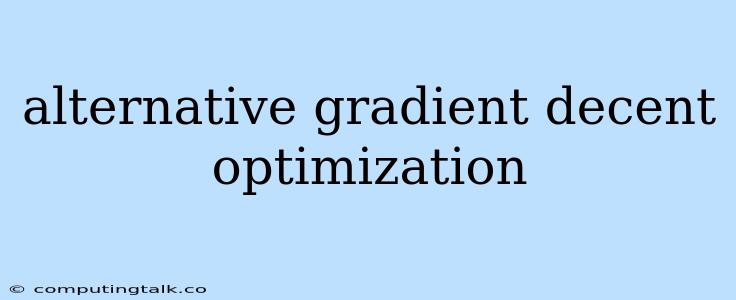Alternative Gradient Descent Optimization: Expanding the Horizons of Machine Learning
Gradient descent is a cornerstone of many machine learning algorithms. It's a powerful optimization technique that helps find the optimal parameters for models by iteratively adjusting them in the direction of the negative gradient of the loss function. This process minimizes the loss function and improves the model's performance. However, traditional gradient descent faces certain limitations, particularly when dealing with complex, high-dimensional data.
This is where alternative gradient descent optimization methods come into play. They offer alternative approaches to address the challenges posed by traditional gradient descent and enhance the efficiency and effectiveness of optimization in machine learning.
What are the Challenges Faced by Traditional Gradient Descent?
-
Local Minima: Gradient descent can get stuck in local minima, which are points where the loss function decreases in all directions but may not be the global minimum. This can lead to suboptimal solutions.
-
Saddle Points: In high-dimensional spaces, gradient descent can encounter saddle points, where the gradient is zero but the function is not at a minimum. This can also hinder the search for the global minimum.
-
Learning Rate: Choosing the right learning rate is crucial for gradient descent. A learning rate that is too high can lead to oscillations, while a learning rate that is too low can make the optimization process very slow.
-
High-Dimensional Data: Gradient descent can struggle with high-dimensional data, which can lead to slow convergence and difficulty finding the global minimum.
Alternative Gradient Descent Optimization Methods: A Deeper Dive
Here are some of the popular alternative gradient descent optimization methods that address the limitations of traditional gradient descent:
-
Momentum: This method introduces a momentum term that helps accelerate the descent in the direction of the previous updates. This reduces the likelihood of getting stuck in local minima and saddle points.
-
Nesterov Accelerated Gradient (NAG): This technique modifies the momentum term by looking ahead at the gradient at the next step. This further improves the convergence speed and accuracy.
-
Adagrad: This method adapts the learning rate for each parameter, making it smaller for frequently updated parameters and larger for infrequently updated parameters. This can help overcome the issue of choosing a suitable learning rate.
-
RMSprop: This technique is similar to Adagrad but incorporates an exponential decay rate for the squared gradient. This helps to prevent the learning rate from decreasing too rapidly.
-
Adam: This algorithm combines the best features of Adagrad and RMSprop. It uses both momentum and adaptive learning rates for efficient and robust optimization.
-
Adadelta: This method improves upon Adagrad by using a decaying average of past squared gradients instead of accumulating them. This helps prevent the learning rate from becoming too small.
-
Stochastic Gradient Descent (SGD): Unlike traditional gradient descent, which uses the entire dataset for each update, SGD uses only a small batch of data. This makes the optimization process much faster, especially for large datasets.
-
Mini-Batch Gradient Descent: This method combines the efficiency of SGD with the stability of traditional gradient descent. It uses batches of data that are smaller than the entire dataset but larger than a single data point.
Benefits of Alternative Gradient Descent Optimization Methods
Alternative gradient descent optimization methods offer numerous benefits:
- Faster Convergence: They can converge much faster than traditional gradient descent, especially for large datasets or complex models.
- Improved Accuracy: They can help to find better solutions by avoiding local minima and saddle points.
- Enhanced Robustness: They are more robust to noise and outliers in the data.
- Flexibility: They can be adapted to different types of data and models.
Choosing the Right Optimization Method
The choice of the best alternative gradient descent optimization method depends on the specific problem and the characteristics of the data. Consider the following factors:
- Dataset Size: For large datasets, SGD or mini-batch gradient descent are typically preferred.
- Data Complexity: For complex data, methods like Adam or Adadelta may be more effective.
- Model Complexity: More complex models may benefit from techniques like NAG or RMSprop.
- Computational Resources: The computational cost of different methods can vary, so it's important to choose a method that is efficient for your resources.
Conclusion
Alternative gradient descent optimization methods have revolutionized machine learning by providing more efficient and robust optimization strategies. They address the limitations of traditional gradient descent and enable faster, more accurate, and more stable training of machine learning models. By understanding the advantages and disadvantages of each method, you can choose the most suitable approach for your specific task. The future of machine learning relies on constantly developing and exploring new optimization techniques like these.
